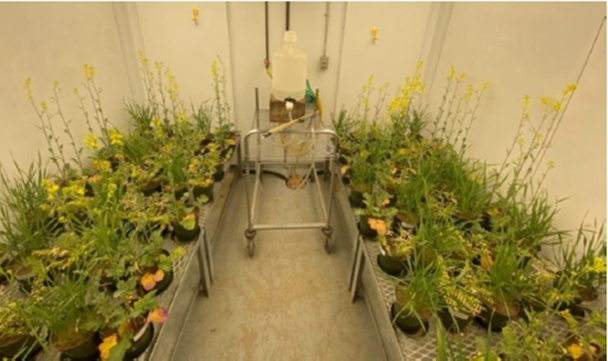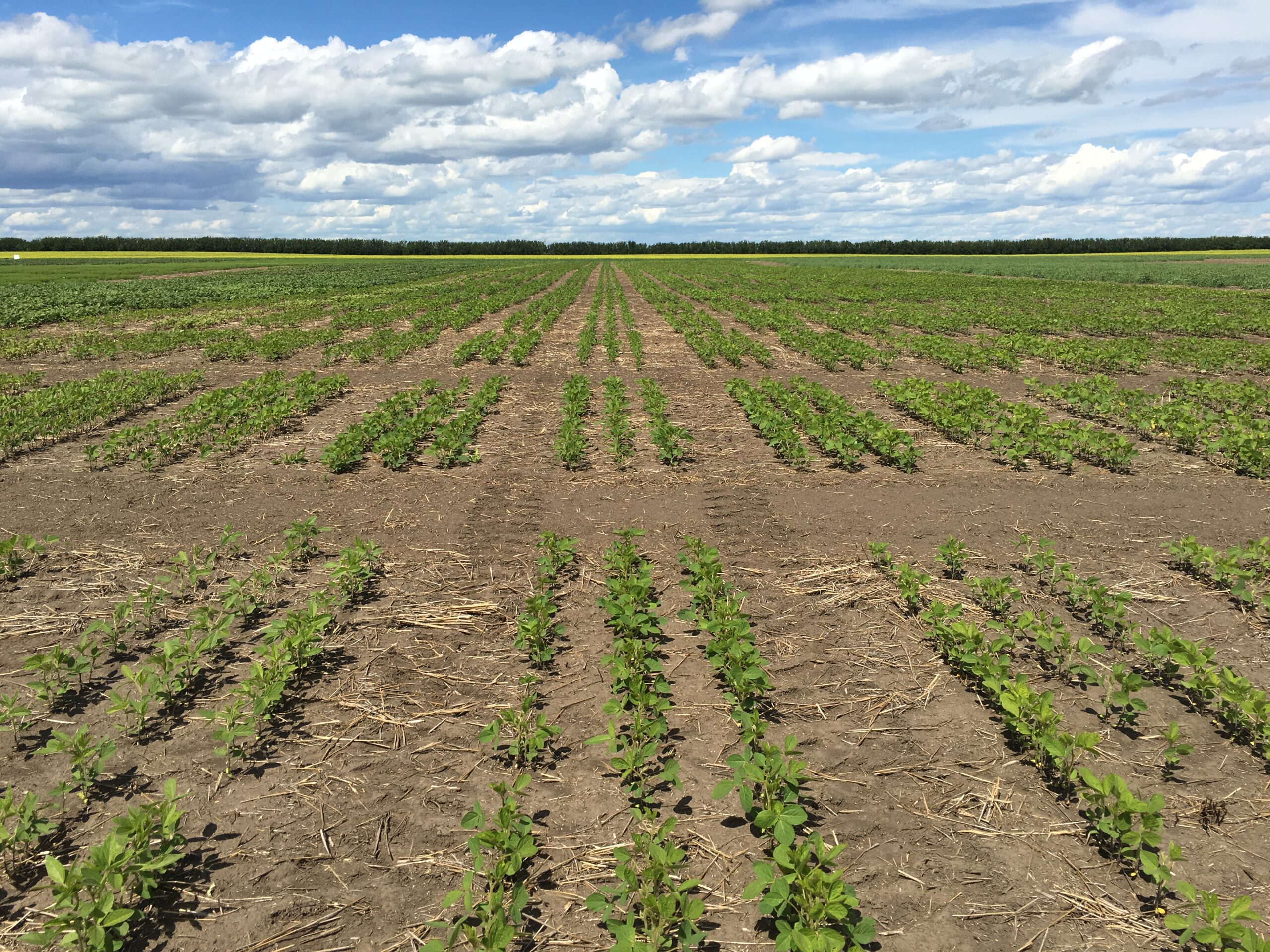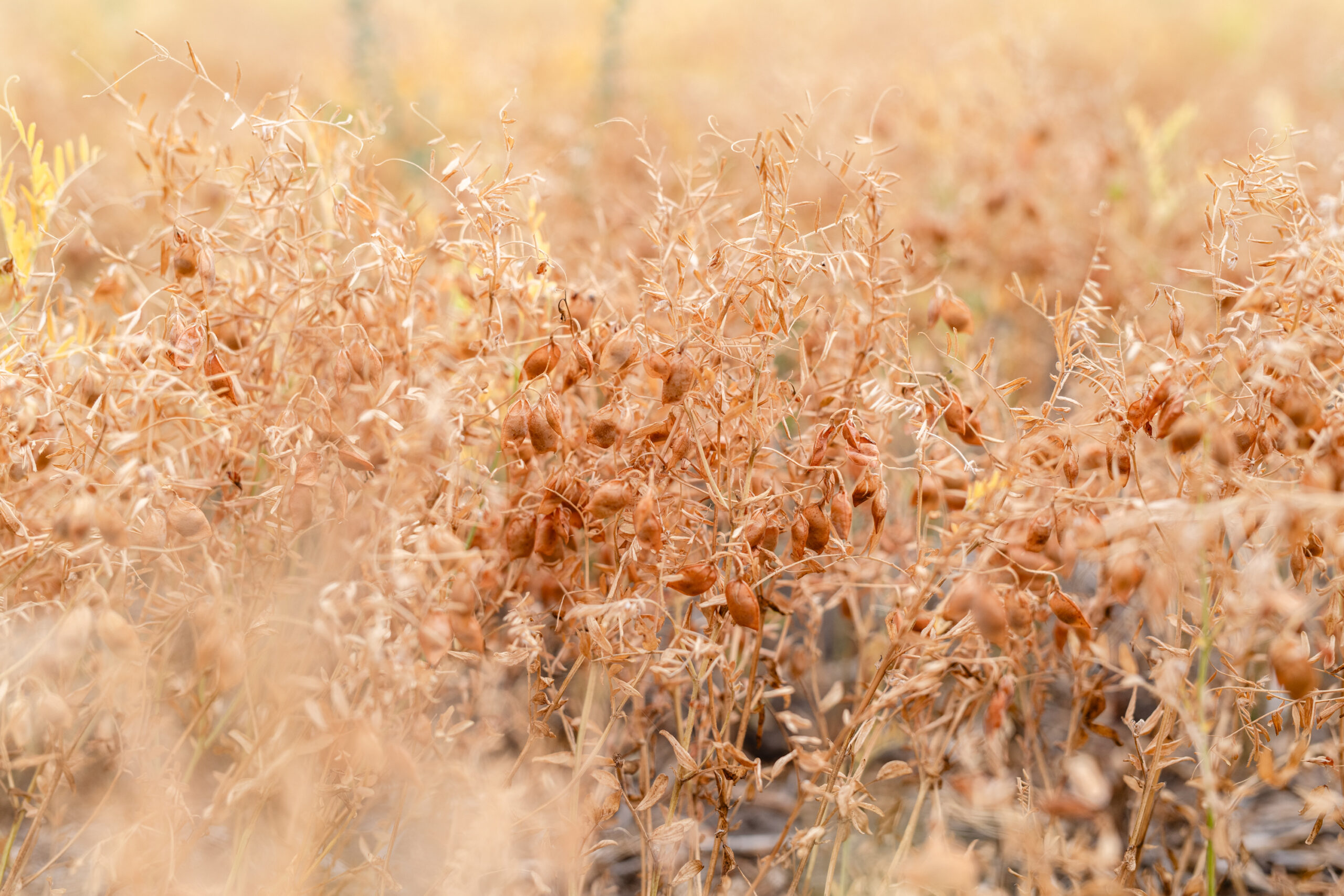Background
4R Nutrient Stewardship Principles (right source, right rate, right place, right time) form a widely recognized and easily understood framework to promote the efficient use of nutrients by maximizing a crop’s utilization of applied nutrients while limiting losses from their place of application.
However, determining what’s “right” with respect to the 4Rs can prove challenging. In the Northern Great Plains, where most runoff and surface water recharge occur during snowmelt, implementing sustainable farming practices requires adopting 4R phosphorus (P) stewardship practices that balance agronomic and environmental outcomes. While the region’s farmers have access to several sources of P, localized landscape and soil characteristics have historically not been considered when 4R practices are prescribed, even though they are key to managing P in variable landscapes more precisely. As a result, the relative agronomic and environmental performance of these P sources under a given set of soil conditions remains largely unknown.
Notably, there are significant differences in soil moisture, organic matter, and pH in upper slope and lower slope landscapes in the Prairie Pothole Region (PPR). While it is assumed that hydrology drives nutrient transport in the landscape, the degree to which soil characteristics, topography and climate influence the “right” combination of P management practices for a given set of soil conditions remains unknown. However, prior work by Wilson et al. (2016) has demonstrated a high correlation between topography and plant-available P.
Decisions regarding optimal application rates for P fertilizer are often made in conjunction with several factors including the method of placement, the amount of P that can safely be applied in or near the seed row, and the rate that’s necessary to either restore P fertility levels lost through crop removal or to build P up to a level required to achieve future targets.
Previous research by multiple investigators has shown that the performance of a given P fertilizer is influenced by its initial chemical formulation and the content of plant-available P, as well as by the type and rate of chemical reactions created between the solution P and soil constituents following application. In addition, past attempts by several investigators to compare the agronomic performance of broadcast versus in-soil banded P fertilizer have yielded inconclusive, crop-dependent results.
Design of Experiment
A three-year wheat-pea-canola rotational study was conducted at three field sites in southern Saskatchewan from 2021 to 2023, each one representing a unique landform element with associated soil and environmental conditions. The goals of the study were to:
- Determine the degree to which localized landscape and soil conditions influence P fertilizer form and its interactions with rate and placement.
- Demonstrate how differences in soil properties and soil-available water across landform elements affect relative agronomic and environmental performance.
- Evaluate whether broadcast or in-soil banded P fertilizer delivers better agronomic performance.
- Improve agronomic and environmental outcomes through optimized, site-specific, beneficial management practice (BMP) P recommendations.
Upslope (CB Upslope) and low-slope (CB Lowslope) sites were situated in a field located one kilometer (km) north of Central Butte, which featured undulating knob and kettle topography. The midslope site (Langham Midslope) was located on relatively level, undulating topography at the Glacier FarmMedia Discovery Farm, approximately eight km west of Langham. Meteorological stations recorded drought conditions at all sites across all three years.
The trial was structured as a randomized complete block design with 36 treatments including combinations of eight fertilizer P forms (Table 1), two application rates (20 kilograms per hectare (kg/ha) and 40 kg/ha P2O5) and two placement methods (sideband and broadcast). There was also an unfertilized control. Treatment combinations were applied in four replicates at each site, with four 1 x 4-meter (m) blocks of each replicate. Soil samples were collected before the initial treatment in 2021, and all sites were found to be deficient in plant-available phosphorus (P) for annual grain production.
Table 1. List of fertilizer P sources by name and chemical analysis used in the study.
| Fertilizer P Name |
Chemical Analysis (%N – %P2O5 – %K2O – %S) |
|---|---|
| Ammonium Phosphate Sulphate (APS) | 17-20-0-15 |
| Liquid Ammonium Polyphosphate (LAP) | 10-34-0-0 |
| Monoammonium Phosphate (MAP) | 11-52-0-0 |
| Polymer Coated MAP (MAPC) | 11-52-0-0 |
| MAP + Elemental Sulfur (MAP+ES) | 9-43-0-16 |
| Rock Phosphate (RP) | 0-3-0-0 |
| Struvite (STRU) | 5-28-0-0 |
| Triple Superphosphate (TSP) | 0-45-0-0 |
In the first year of the study, Canada Western Red Spring (CWRS) wheat (var. AAC Connery) was seeded at a rate of 120 kg/ha in mid-May 2021 at all three sites using a plot seeder with a one m wide tool bar featuring four openers on 25.4 centimeter (cm) spacing and a double-shoot opener configuration to allow for independent placement of seed and fertilizer. For side-band treatments, fertilizer was placed in a band approximately 1.9 cm below and 1.9 cm to the side of the seed row. For the broadcast treatments, fertilizer was broadcast using a hand spreader immediately before seeding, with some incorporation occurring during the seeding process.
Green field peas (var. CDC Striker) and canola (var. L233P) were seeded in mid-May 2022 and 2023, respectively, at all three sites (Figure 1). Peas were inoculated before seeding.
Total nitrogen (N) and sulphur (S) application rates were maintained at all sites by adding urea or potassium sulphate as needed. Weeds were controlled using a combination of registered pre-seed and in-crop herbicide applications. In 2021, in-crop herbicides were applied to wheat at the four-leaf stage at label rates for all three sites. In 2022, herbicides were applied to peas before seeding and in-crop at the 3-6 node stage at label rates for all three sites. In 2023, herbicide was applied as a combination of pre-emergent and in-crop products for weed control in the canola crop.
The wheat grown at the three sites in 2021 was harvested in August (Figure 2) and then air-dried until threshing. Grain yield was weighed and recorded on a kilogram per hectare (kg/ha) basis. Straw yield was determined by subtracting grain yield from total biomass, and crop nutrient uptake was determined by grinding crop residue sub-samples from each plot and subjecting them to an acid digest.
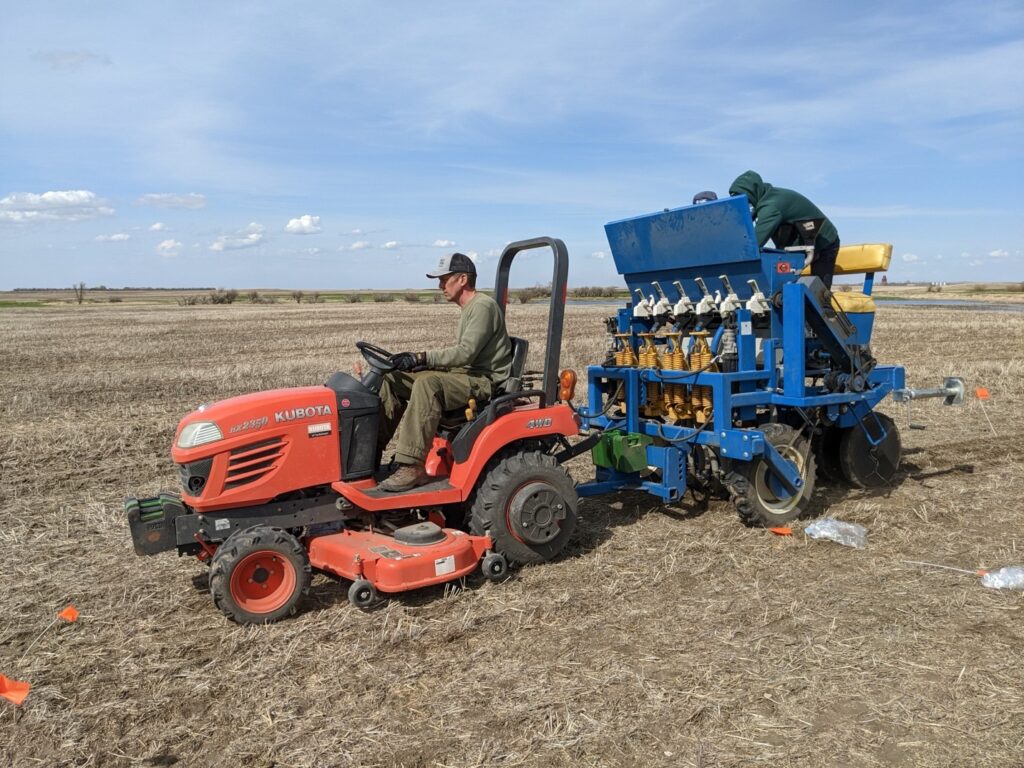

In early August 2022, peas were harvested at all three sites. In early August 2023, hand-collected canola harvest samples were obtained from all three sites, then air-dried to determine grain and straw yields and to collect samples for nutrient analysis.
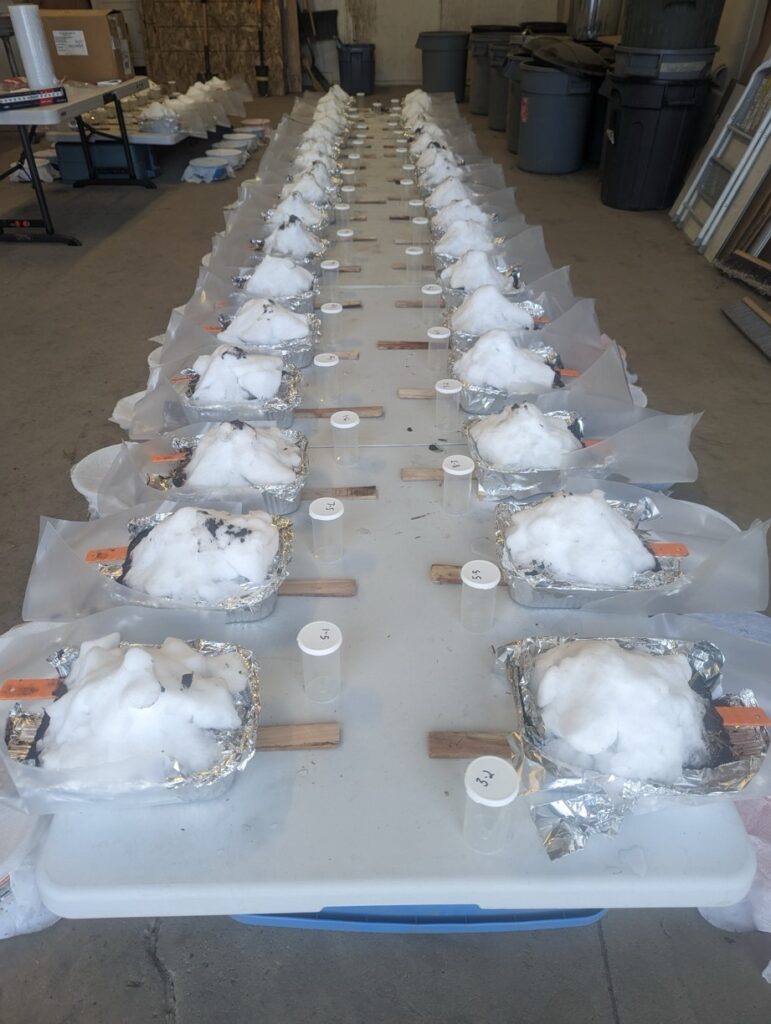
For all three study years, post-harvest soil sampling was conducted between late August and early September at all three sites by collecting individual surface (0-15 cm) samples from both seed rows and between-row locations within each plot, then bulking them together as a composite sample for analysis by plot.
An additional field season was added to the study for 2024 to assess the legacy impacts of various P fertilizer sources on wheat nutrient uptake and yield.
Following threshing, grain yields, P uptake and post-harvest residual soil-available P were measured in a replicated experiment along with soluble P concentration in simulated snowmelt runoff (Figure 3). The “sandwich” test, outlined by Qian et al. (2008), was used to measure the soil P supply rate using anion exchange membranes. A water-extractable P soil test, as described by Sharpley et al. (2008), was used as a proxy for P released during a runoff event.
Results
P fertilizer source and placement had the most significant impact on both agronomic performance, including yield, P uptake, and recovery of P fertilizer, and environmental performance (P concentration and P load in snowmelt runoff) during this three-year wheat-pea-canola rotational study in southern Saskatchewan. Study results were influenced by varying soil, crop, and landscape factors; however, in general, measurements of crop uptake and recovery indicated that less soluble P fertilizer sources were associated with lower plant availability. However, snowmelt runoff water losses were also lower for less soluble P forms across all sites when compared to more soluble P sources. Therefore, less soluble P fertilizer sources, such as struvite or rock phosphate, may be suitable for site-specific application to fields located near sensitive water bodies where there is a high risk of P transport off-site.

Results also showed that upslope locations and soils with inherent limitations on crop growth and P utilization exported greater amounts of P in snowmelt. The accumulation of soil residual P associated with reduced crop uptake and removal of applied P fertilizer relative to the rate of P fertilizer application was also found to be a significant driver of increased P transport in snowmelt runoff.
At both upslope and low-slope sites, polymer-coated monoammonium phosphate produced the highest residual soil-available P after three years, which may reflect reduced fixation rates in the soil due to the slow release. Upslope and midslope sites, where yield and crop P removal over the crop rotation was lower and where surface soils became enriched with soil test P, experienced greater losses of P in snowmelt runoff.
Another notable finding was that side-banded placement was slightly more advantageous than spring surface broadcast and incorporation in promoting greater crop P uptake and apparent P recovery, while also reducing total P load in runoff. However, it is important to note that the observed benefits may have been muted by the immediate incorporation of the broadcast fertilizer during post-application seeding.
Implications for Growers
Study sites were selected to represent the varying soil and landscape conditions encountered across Saskatchewan. The agronomic and environmental performance of P fertilizers in a cereal-pulse-oilseed rotation varied across these diverse sites.
The results of this study show that selecting the “right” combination of 4R Nutrient Stewardship practices depends on the site conditions. Water is a key factor influenced by topography, along with soil properties such as organic matter and salinity, which also affect crop P demand and removal. Along with rate, placement, and timing, the research revealed that the form (source) of P fertilizer selected is an important consideration when attempting to optimize P fertilizer performance.
This study advances our collective understanding of the factors that influence the agronomic and environmental performance of various P fertilizer sources, which can lead to improved crop yield, P uptake, and recovery, as well as reduced P losses in snowmelt runoff.
Differences in performance across the varied sites means that localized landscape and soil characteristics must be accounted for to ensure that farmers are prescribed the “right” combination of 4R P stewardship practices that promotes crop uptake of applied P fertilizer and prevents the accumulation of residual P in the surface soil, which is prone to being lost in snowmelt runoff.
For farmers seeking to minimize P losses in areas of their fields where the risk of P transport is high, this study identifies a selection of less soluble P sources, albeit sometimes with lower plant availability.
This study further demonstrated that S-containing P fertilizer sources have the potential to provide farmers with a slight advantage by enhancing P availability for rotational canola, wheat, and pea crops, particularly on high-pH, calcareous soils, where P availability is limited due to soil fixation.
To help farmers predict P loading and runoff risk, it is deemed valid to calculate surpluses or deficits associated with P fertilizer additions relative to P removals in harvest over many years.
Acknowledgements
Project Lead: Dr. Jeff Schoenau, Professor and Ministry of Agriculture Strategic Research Program (SRP) Chair in Soil Nutrient Management, University of Saskatchewan
Graduate Student: Dr. Blake Weiseth, Corporate Agronomist, Western Ag
Collaborator: Dr. Jane Elliott, Research Scientist, Global Institute for Water Security, University of Saskatchewan
Project Funding: Saskatchewan Pulse Growers (SPG), Saskatchewan Wheat Development Commission (Sask Wheat), Sask Oilseeds, Western Grains Research Foundation (WGRF), Foundation for Agronomic Research (FAR).
